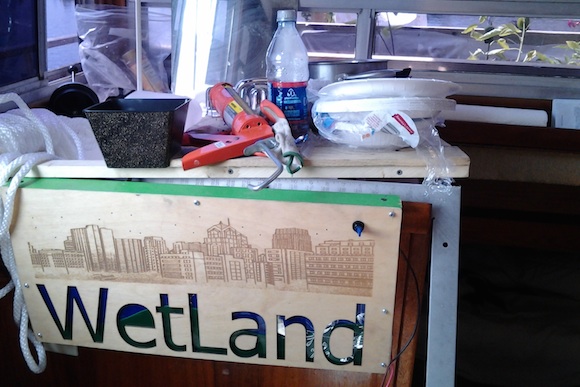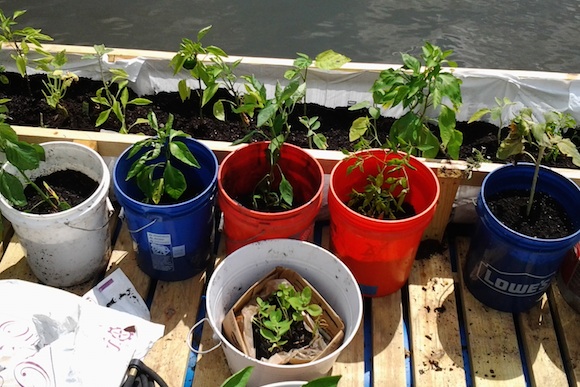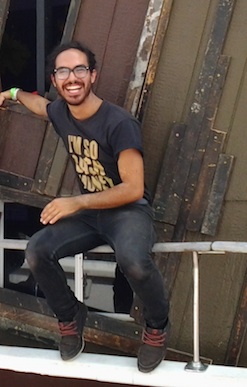Esteban Silva, sporting a ring through his nose and large black-framed glasses, is standing in the hot cabin of WetLand, a houseboat converted into an eco-friendly live-in public art installation, bobbing gently on the Philadelphia shore of the Delaware River. It's the crew's last day on the city's electrical grid, and he's stirring a pan of spinach and garlic on a single induction cooktop.
Silva, who plays the accordion and trumpet in a “chamber punk” band called Wood Spider, has been working with Mary Mattingly, the artist behind WetLand, since he was a SUNY Purchase student a few years ago.
The Project is part of this year's Philadelphia Fringe Festival, an annual test of just how far local and international artists can go. The Brooklyn-based Mattingly's WetLand, created with the help of Silva, and artist and “food technologies” maven Greg Lindquist, may be the most ambitious and interdisciplinary Fringe project yet.
Last year, the former Live Arts Festival and Philly Fringe rebranded — and opened a new Columbus Boulevard headquarters — as FringeArts, offering the Presented Fringe as well as an un-curated performance free-for-all throughout the region known as the Neighborhood Fringe (it all runs September 5 through 21).
Presented Fringe's WetLand — “part interactive art installation, part urban farm, and part gathering place, education center and artist's studio,” according to FringeArts — will be open to visitors through September 21, free of charge, at its location at the Independence Seaport Museum dock at Penn's Landing.
Mattingly's inspiration for the floating live-in farm and arts mecca is a world of coastal living in rising waters. The houseboat itself, adapted and decorated with reclaimed and recycled wood, is meant to evoke a home that is sinking into the water.
Flying Kite visited Mattingly, Esteban and Lindquist in early August while the project was still coming together. Esteban and Mattingly, who will live on the boat throughout the festival, had already been residing onboard for a few weeks as the build on the boat commenced.
The vessel itself, a 1971 Rockwell Whitcraft houseboat, came from Jacksonville, Florida, where it was a floating office. She brought the boat by land as far as Westville, New Jersey, where it finally hit mid-Atlantic waters, docking at the pier behind the Seaport Museum in late July.
“I own this boat. We're building it to last,” says Mattingly of her long-range plans. “After Fringe, there presents the problem, or the proposition, of where does this go?”
She hopes WetLand will have a life in other cities after its Philadelphia debut.
The finished project will boast an extraordinary range of features. Solar panels will power the stove and fridge. There will be a composting toilet, a tiny library, sleeping quarters, a space for public dinners, lectures and performances for an audience of about 20, and a loft with an art studio, hosting six different artist residencies.
Sawdust drifts gently from a fresh hole in the ceiling that reveals the in-progress art studio. Silva adds eggs to the pan of spinach and garlic and serves the steaming plates. Bandit, Lindquist's black-and-white cat — also living onboard for the build along with Mattingly's calico, Papaya — winds his way across a workbench, rubbing his face against a riot of lamps, paint trays, drills, and other tools.
Bandit and Papaya will leave the boat for Lindquist's nearby apartment before WetLand opens to the public, but that won't make the floating arts and farming hub any less crowded. The resident artists will live on food grown on the boat and its surrounding adapted docks. Mattingly says there will be an “observational hive” donated by the Philadelphia Beekeepers Guild, as well as chickens, temporarily acquired through Rent a Coop, contributing their eggs to the colony's table.
WetLand floats in a flourishing perimeter of plants and compost which will feed the artists and visitors throughout the festival. According to Lindquist, the crops include peppers, heirloom tomatoes, squash, eggplant, onions, sunflowers, spinach, lettuce, kale, carrots, melons, strawberries and an herb garden (the potatoes didn't work out).
“We're making do with what we've got and figuring it out from there,” says Silva of managing the building and growing process, while incorporating as many sustainably-sourced or recycled materials and plants as possible.
What about the plastic cup half-full of water taped to the ceiling of the main cabin?
That's not an exercise in sustainability. It's just a leak no-one expected.
“When we started building, we didn't really know what we were doing,” admits Mattingly. Nautical engineer Rik van Hemmen was instrumental in that process, making sure the floating structure laden with everything from benches to gardens to solar panels would be safe to board.
The project is already the result of some nationwide collaboration. An engineering class at Humboldt State University helped design a water filtration test system that resides in the boat's man-made wetland of veggie-populated docks and rafts, floating with the help of salvaged plastic bottles and empty 55-gallon drums.
In addition to all the other questions of whether one boat can be a successful experiment in sustainable living as well as an arts hub, Mattingly wants to study how effective a man-made wetland environment could be on our increasingly inundated coasts.
The WetLand water system tests “the viability of human-built wetlands,” explains Mattingly, searching for nutrients and pollutants at their site in the Delaware at high tide and low tide, to discover if their garden and living set-up could affect the river environment for the better.
Other WetLand collaborators include Recycled Artist in Residency and The Resource Exchange, who donated supplies for the build of the structure and systems. Teachers and students from Philadelphia's Workshop School helped create the gutter systems that capture rainwater for drinking, washing and watering the plants. The Workshop School also made signage for the project, and the interior benches that will seat visitors for a range of events, from concerts and readings to tastings and workshops, which will run throughout the Festival.
As Mattingly and her fellow artist-innovators eat their spinach-garlic eggs and explain the projects, a gaggle of summer-camp kids gently rock the boat with the wakes of their kayaks as they cruise by to look at the gardens.
“We're all feeling some degree of disembarkment syndrome,” Lindquist says of feeling wobbly when he steps back on land.
But however isolating the project might seem, all three artists insist that the point of this off-the-grid watery venture is actually the need for connection.
“It's not completely self-sufficient,” Mattingly insists of “gaps in the system” that will remain despite everyone's best efforts. “The hardest part of thinking about self-sufficiency is how isolated you can become from everyone else.”
“There's this very romantic Thoreau-esque idea of splitting yourself off from society,” Silva adds, but as far as real sustainability, that doesn't hold water.
For his part, Lindquist points to a rumor that even the great Thoreau mother's made a habit of bringing him cookies.
The project fosters the spirit of collaboration needed for truly sustainable living, as everyone on the team contributes a different type of expertise to make the whole idea work.
“Every time we have guests step on board, we learn something new,” says Silva.
To learn more about WetLand and its Fringe Festival event schedule, visit the website.
ALAINA MABASO, a Philadelphia-based freelance journalist, has landed squarely in what people tell her is the worst possible career of the twenty-first century. So she makes Pennsylvania her classroom, covering everything from business to theater to toad migrations. After her editors go to bed, she blogs at http://alainamabaso.wordpress.com/. Find her on Twitter @AlainaMabaso.





